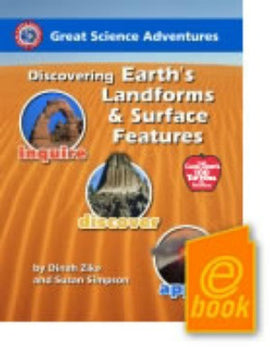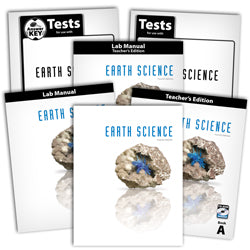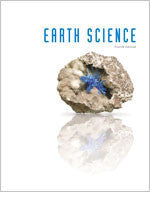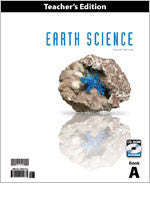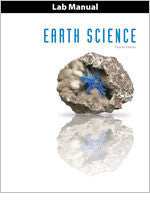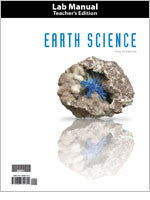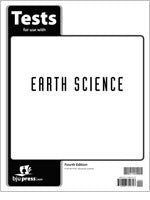BJU Press Earth Science Student Text, 4th Ed
This item is on backorder from BJU Press, however, it is still available for ordering.
Earth Science, 4th Ed. is an expedition. Your students will find themselves climbing mountains, diving into the oceans, and launching into the skies on a quest to learn how the world works.
During this quest, students will find that Earth science is also a battle of worldviews. This text clearly introduces students to the secular theories of where everything they see came from. They critique these theories. For each secular theory, the text affirms the conservative biblical view of Earth’s history shaped by Creation, the Fall, and the Flood. Students’ Christian worldviews will be shaped and strengthened as they learn about tectonic processes, landforms and earth materials, fossils, the oceans and oceanography, rivers and lakes, the atmosphere, weather and storms, climate and environmentalism, the solar system, the universe and cosmology, and space science.
Table of Contents -
- Why Study Earth Science?
- A Christian Approach to Earth Science
- Earth Science in Action
- Matter
- Forces and Matter
- Energy and Matter
- Composition of Matter
- Who Do We Use Maps?
- Types of Maps
- Maps and GIS
- The Earth, a Special Place
- Geology, the Science
- The Earth's Structure
- The Earth's Natural Resources
- Origin of the Earth
- A History of Change
- Tectonics: An Agent of Change
- Tectonic Forces
- Faults and Joints
- Earth Waves and Seismology
- Effects of Earthquakes
- What is a Mountain?
- Tectonic Mountains
- Non-Tectonic Hills and Mountains
- Fire Mountains
- Classifying Volcanoes
- Intrusive Volcanism
- Describing Minerals
- Identifying Minerals
- Minerals as Resources
- Classifying Rocks
- Igneous Rocks
- Sedimentary Rocks
- Metamorphic Rocks
- The "Rock Cycle"
- Fossilization
- Paleontology
- Fossil Fuels
- Weathering
- Erosion and Deposition
- Soil
- Ocean Basins
- Seawater
- Ocean Environments
- Tides
- Currents
- Waves
- The History of Ocean Exploration
- Oceanography in Action
- Entering an Alien World
- Streams
- Lakes and Ponds
- Underground Reservoirs
- Groundwater Chemistry
- Water as a Resource
- Groundwater Landforms
- What Is the Atmosphere?
- Special Zones In the Atmosphere
- Energy In the Atmosphere
- What is Weather?
- Special Zones In the Atmosphere
- Energy In the Atmosphere
- What Is Weather?
- Winds
- Clouds and Precipitation
- Air Masses and Fronts
- Severe Weather
- Weather Forecasts
- What Is Climate?
- Climate Zones
- Climate Change
- The Sun
- The Moon
- The Sun, Moon, and Earth as a System
- Modeling the Solar System
- The Planets
- Nonplanetary Objects
- Stars
- Gas to Galaxies
- The Universe
- Telescopes
- Rockets, Satellites, and Probes
- Manned Space Exploration
- Appendix A: Understanding Scientific Terms
- Appendix B: Math Principles and Graphing
- Appendix C: Periodic Table of the Elements
- Appendix D: Topographic Map Symbols
- Appendix E: World Physiographic Map
- Appendix F: World Plate Tectonics Map
- Appendix G: Geologic Column
- Appendix H: Modified Mercalli Index Earthquake Intensity Scale
- Appendix I: United States Elevation and Landform Maps
- Appendix J: Mineral Identification Key
- Appendix K: Rock Classification Key
- Appendix L: Relative Humidity Graph
- Appendix M: Tornado/Hurricane Category Scales
- Appendix N: Weather Station Model
- Appendix O: World Climate Zone Map
- Appendix P: Solar System Data
- Appendix Q: Seasonal Star Charts
- Glossary
- Index
- Photo Credits
Softcover, 728 pages.
ISBN - 9781606820704
SKU 1071486
| Book Title | BJU Press Earth Science Student Text, 4th Ed |
| Publisher: | Bob Jones University |
| ISBN |
This item is on backorder from BJU Press, however, it is still available for ordering.
Earth Science, 4th Ed. is an expedition. Your students will find themselves climbing mountains, diving into the oceans, and launching into the skies on a quest to learn how the world works.
During this quest, students will find that Earth science is also a battle of worldviews. This text clearly introduces students to the secular theories of where everything they see came from. They critique these theories. For each secular theory, the text affirms the conservative biblical view of Earth’s history shaped by Creation, the Fall, and the Flood. Students’ Christian worldviews will be shaped and strengthened as they learn about tectonic processes, landforms and earth materials, fossils, the oceans and oceanography, rivers and lakes, the atmosphere, weather and storms, climate and environmentalism, the solar system, the universe and cosmology, and space science.
Table of Contents -
- Why Study Earth Science?
- A Christian Approach to Earth Science
- Earth Science in Action
- Matter
- Forces and Matter
- Energy and Matter
- Composition of Matter
- Who Do We Use Maps?
- Types of Maps
- Maps and GIS
- The Earth, a Special Place
- Geology, the Science
- The Earth's Structure
- The Earth's Natural Resources
- Origin of the Earth
- A History of Change
- Tectonics: An Agent of Change
- Tectonic Forces
- Faults and Joints
- Earth Waves and Seismology
- Effects of Earthquakes
- What is a Mountain?
- Tectonic Mountains
- Non-Tectonic Hills and Mountains
- Fire Mountains
- Classifying Volcanoes
- Intrusive Volcanism
- Describing Minerals
- Identifying Minerals
- Minerals as Resources
- Classifying Rocks
- Igneous Rocks
- Sedimentary Rocks
- Metamorphic Rocks
- The "Rock Cycle"
- Fossilization
- Paleontology
- Fossil Fuels
- Weathering
- Erosion and Deposition
- Soil
- Ocean Basins
- Seawater
- Ocean Environments
- Tides
- Currents
- Waves
- The History of Ocean Exploration
- Oceanography in Action
- Entering an Alien World
- Streams
- Lakes and Ponds
- Underground Reservoirs
- Groundwater Chemistry
- Water as a Resource
- Groundwater Landforms
- What Is the Atmosphere?
- Special Zones In the Atmosphere
- Energy In the Atmosphere
- What is Weather?
- Special Zones In the Atmosphere
- Energy In the Atmosphere
- What Is Weather?
- Winds
- Clouds and Precipitation
- Air Masses and Fronts
- Severe Weather
- Weather Forecasts
- What Is Climate?
- Climate Zones
- Climate Change
- The Sun
- The Moon
- The Sun, Moon, and Earth as a System
- Modeling the Solar System
- The Planets
- Nonplanetary Objects
- Stars
- Gas to Galaxies
- The Universe
- Telescopes
- Rockets, Satellites, and Probes
- Manned Space Exploration
- Appendix A: Understanding Scientific Terms
- Appendix B: Math Principles and Graphing
- Appendix C: Periodic Table of the Elements
- Appendix D: Topographic Map Symbols
- Appendix E: World Physiographic Map
- Appendix F: World Plate Tectonics Map
- Appendix G: Geologic Column
- Appendix H: Modified Mercalli Index Earthquake Intensity Scale
- Appendix I: United States Elevation and Landform Maps
- Appendix J: Mineral Identification Key
- Appendix K: Rock Classification Key
- Appendix L: Relative Humidity Graph
- Appendix M: Tornado/Hurricane Category Scales
- Appendix N: Weather Station Model
- Appendix O: World Climate Zone Map
- Appendix P: Solar System Data
- Appendix Q: Seasonal Star Charts
- Glossary
- Index
- Photo Credits
Softcover, 728 pages.
ISBN - 9781606820704
SKU 1071486




